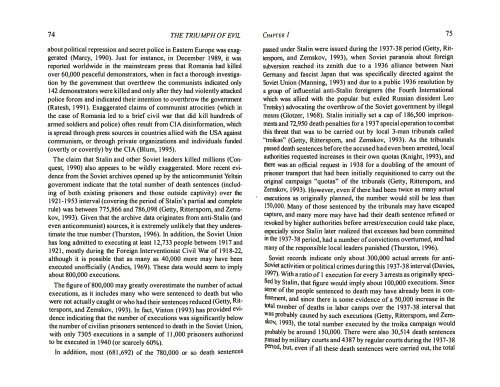austin-murphy-the-triumph-of-evil
austin-murphy-the-triumph-of-evil
austin-murphy-the-triumph-of-evil
You also want an ePaper? Increase the reach of your titles
YUMPU automatically turns print PDFs into web optimized ePapers that Google loves.
74 THE TRIUMPH OF EVIL<br />
about political repression and secret police in Eastern Europe was exaggerated<br />
(Marcy, 1990). Just for instance, in December 1989, it was<br />
reported worldwide in <strong>the</strong> mainstream press that Romania had killed<br />
over 60,000 peaceful demonstrators, when in fact a thorough investigation<br />
by <strong>the</strong> government that overthrew <strong>the</strong> communists indicated only<br />
142 demonstrators were killed and only after <strong>the</strong>y had violently attacked<br />
police forces and indicated <strong>the</strong>ir intention to overthrow <strong>the</strong> government<br />
(Ratesh, 1991 ). Exaggerated claims <strong>of</strong> communist atrocities (which in<br />
<strong>the</strong> case <strong>of</strong> Romania led to a brief civil war that did kill hundreds <strong>of</strong><br />
armed soldiers and police) <strong>of</strong>ten result from CIA disinformation, which<br />
is spread through press sources in countries allied with <strong>the</strong> USA against<br />
communism, or through private organizations and individuals funded<br />
(overtly or covertly) by <strong>the</strong> CIA (Blum, 1995).<br />
The claim that Stalin and o<strong>the</strong>r Soviet leaders killed millions (Conquest,<br />
1990) also appears to be wildly exaggerated. More recent evidence<br />
from <strong>the</strong> Soviet archives opened up by <strong>the</strong> anticommunist Ye ltsin<br />
government indicate that <strong>the</strong> total number <strong>of</strong> death sentences (including<br />
<strong>of</strong> both existing prisoners and those outside captivity) over <strong>the</strong><br />
1921-1953 interval (covering <strong>the</strong> period <strong>of</strong> Stalin's partial and complete<br />
rule) was between 775,866 and 786,098 (Getty, Rittersporn, and Zemskov,<br />
1993). Given that <strong>the</strong> archive data originates from anti-Stalin (and<br />
even anticommunist) sources, it is extremely unlikely that <strong>the</strong>y underestimate<br />
<strong>the</strong> true number (Thurston, 1996). In addition, <strong>the</strong> Soviet Union<br />
has long admitted to executing at least 12,733 people between 1917 and<br />
1921, mostly during <strong>the</strong> Foreign Interventionist Civil War <strong>of</strong> 1918-22,<br />
although it is possible that as many as 40,000 more may have been<br />
executed un<strong>of</strong>ficially (Andics, 1969). These data would seem to imply<br />
about 800,000 executions.<br />
The figure <strong>of</strong> 800,000 may greatly overestimate <strong>the</strong> number <strong>of</strong> actual<br />
executions, as it includes many who were sentenced to death but who<br />
were not actually caught or who had <strong>the</strong>ir sentences reduced (Getty, Rit<br />
tersporn, and Zemskov, 1993). In fact, Vinton (1993) has provided evidence<br />
indicating that <strong>the</strong> number <strong>of</strong> executions was significantly below<br />
<strong>the</strong> number <strong>of</strong> civilian prisoners sentenced to death in <strong>the</strong> Soviet Union,<br />
with only 7305 executions in a sample <strong>of</strong> 11,000 prisoners authorized<br />
to be executed in 1940 (or scarcely 600/o ).<br />
In addition, most (681 ,692) <strong>of</strong> <strong>the</strong> 780,000 or so death sentences<br />
•<br />
CHAPTER J<br />
passed under Stalin were issued during <strong>the</strong> 1937-38 period (Getty, Rit<br />
terspom, and Zemskov, 1993), when Soviet paranoia about foreign<br />
subversion reached its zenith due to a 1936 alliance between Nazi<br />
Germany and fascist Japan that was specifically directed against <strong>the</strong><br />
Soviet Union (Manning, 1993) and due to a public 1936 resolution by<br />
a group <strong>of</strong> influential anti-Stalin foreigners (<strong>the</strong> Fourth International<br />
which was allied with <strong>the</strong> popular but exiled Russian dissident Leo<br />
Trotsky) advocating <strong>the</strong> overthrow <strong>of</strong> <strong>the</strong> Soviet government by illegal<br />
means (Glotzer, 1968). Stalin initially set a cap <strong>of</strong> 186,500 imprisonments<br />
and 72,950 death penalties for a 1937 special operation to combat<br />
this threat that was to be carried out by local 3-man tribunals called<br />
''troikas" (Getty, Ritterspom, and Zemskov, 1993). As <strong>the</strong> tribunals<br />
passed death sentences before <strong>the</strong> accused had even been arrested, local<br />
authorities requested increases in <strong>the</strong>ir own quotas (Knight, 1993), and<br />
<strong>the</strong>re was an <strong>of</strong>ficial request in 1938 for a doubling <strong>of</strong> <strong>the</strong> amount <strong>of</strong><br />
prisoner transport that had been initially requisitioned to carry out <strong>the</strong><br />
original campaign "quotas" <strong>of</strong> <strong>the</strong> tribunals (Getty, Ritterspom, and<br />
Zemskov, 1993). However, even if <strong>the</strong>re had been twice as many actual<br />
executions as originally planned, <strong>the</strong> number would still be less than<br />
150,000. Many <strong>of</strong> those sentenced by <strong>the</strong> tribunals may have escaped<br />
capture, and many more may have had <strong>the</strong>ir death sentence refused or<br />
revoked by higher authorities before arrest/execution could take place,<br />
especially since Stalin later realized that excesses had been committed<br />
in <strong>the</strong> 1937-38 period, had a number <strong>of</strong> convictions overturned, and had<br />
many <strong>of</strong> <strong>the</strong> responsible local leaders punished (Thurston, 1996).<br />
Soviet records indicate only about 300,000 actual arrests for anti<br />
Soviet activities or political crimes during this 193 7-3 8 interval (Davies,<br />
1997). With a ratio <strong>of</strong> 1 execution for every 3 arrests as originally speci<br />
fied by Stalin, that figure would imply about 100,000 executions. Since<br />
some <strong>of</strong> <strong>the</strong> people sentenced to death may have already been in confinement,<br />
and since <strong>the</strong>re is some evidence <strong>of</strong> a 50,000 increase in <strong>the</strong><br />
total number <strong>of</strong> deaths in labor camps over <strong>the</strong> 1937-38 interval that<br />
was probably caused by such executions (Getty, Ritterspom, and Zemskov,<br />
1 993), <strong>the</strong> total number executed by <strong>the</strong> troika campaign would<br />
probably be around 150,000. There were also 30,5 14 death sentences<br />
pas�ed by military courts and 4387 by regular courts during <strong>the</strong> 1937-38<br />
J)enod, but, even if all <strong>the</strong>se death sentences were carried out, <strong>the</strong> total<br />
75


